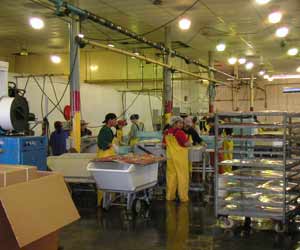Worker Profile: Life Working in a Salmon Cannery
Michael Dessner spent a summer working at a fish processing plant near Kenai.
The buzz of your alarm clock rouses you to a new day of salmon cannery work in Alaska. If you’re fortunate, you aren’t suffering from last night’s bout with
Lucky Lager and the sun is shining brightly. More than likely the sky (and your brain) is clouded over.
A quick breakfast of instant oatmeal revives you for the walk to the plant and the coffee in the break room, where you’ll await the day’s activities. Fish or no fish? Mother Nature provides, but at her own pace. A good day for the fishermen means it could be 16 hours before you see the inside of your sleeping bag again.

Sometime between your second and third cup of coffee and a little catching up on camp gossip, you get the word: “fish on!” A mad scramble for the gear room ensues. A decent set of gloves and a sturdy apron are high priorities. Punch the clock and you’re ready – off to the line!
You’re lucky enough to find a spot at the racks, but the foreman grabs you for the slime line. You grin and bear it. If fortune smiles on you, you’ll be relieved and sent somewhere else – anywhere else. At least you don’t have holes in your gloves and are thus somewhat protected by the icy wash of the tank.
One 15-minute break and five hours later, you gratefully punch out for a 45-minute lunch. Some people bolt for their tents, but you’ve got your trusty PB&J sandwich, a Cup-o’-Soup, and a granola bar. Anything is better than the $4 mystery burger!
After lunch, true to form, your foreman has found someone to take your place at the dreaded tank and you gratefully assume a spot on the spoon line. The next 5-10 hours are taken up performing this task, punctuated by intermittent gut fights and singing along to music you can barely hear over the machinery.
When it’s all over you wearily plod back to the Tent City, secure in the knowledge that you’ve turned in a solid day of work (made easier by the fact that each overtime hour brings $15 extra). You’re greeted by blue tarps and the delicious aroma of frying salmon. No ramen noodles tonight; the foreman gave the crew some too-small reds (sockeye salmon) for their own consumption. After some food and conversation with new friends you’ll never forget, it’s off to bed. Your sleeping pad feels like a feather bed, and if there’s no work tomorrow a hitch down the road will reveal uncharted territory. Alaska is a big place, and there is almost always something new in a day of the life of a salmon cannery worker.


 Teach English in Asia
Teach English in Asia  Cruise Ship Jobs
Cruise Ship Jobs  Alaska Fishing Industry Jobs
Alaska Fishing Industry Jobs  Sharing Economy / Gig Economy
Sharing Economy / Gig Economy